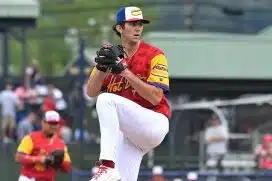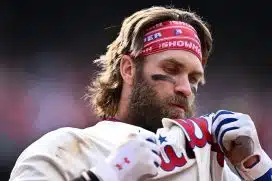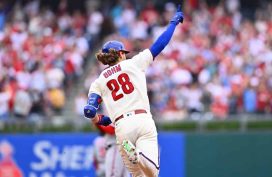By Tal Venada, Sports Talk Philly Contributor
For the Philadelphia Phillies faithful and major league supporters, knowing the value of hurlers can ease the roller-coaster stress of meaningful September baseball. Realistically, many disappointments come from sky-high expectations unfulfilled. But some emotional investment is controllable. Don’t overreact!
The Factors:
Emphasizing a rough patch for a pitcher, a bad outing or even an exemplary performance clouds the overall evaluation any team has made. For many Phillies fans, though, this is their first pennant race since 2011, and many will magnify everything: each game, play and pitch.
IN OTHER WORDS:
“The rankings are quite volatile: Today you're 'great,' tomorrow you're 'not,' but then you're 'great' again. Now, I always look at the long term and by doing that, obviously, I can stay calm through the storm.” – Roger Federer
Management’s view of their on-field personnel is quite different from their fans. For one, they realize most hurlers aren’t going to succeed in every appearance, and their expectation is 75-80 percent. And they also know an ace can struggle, but a marginal starter can twirl a gem at any time.
While many supporters determine a pitcher’s worth by his ERA, it isn’t the only assessment tool. Basically, a “fourth or fifth slot” arm rarely works more than five innings and sometimes doesn’t record 15 outs. And iffy control is the main reason they quickly use 100 bullets (20 per frame) except for a tight strike zone or many foul balls.
In fact, moundsmen who can command four pitches or more have a better chance of going at least six innings even if one arrow from their quiver is off target. However, missing with a fastball is a troubling tell: It can lead to a short appearance, mop-up relievers, and possibly a position player on the mound.
When a starter averages around 5 ⅔ innings per outing, he’s a one, two or three. Then, his stats determine which spot he fills. To illustrate, Dave Dombrowski, president of baseball operations, views Zach Eflin as a three-slot arm based on his numbers and control.
When Dombrowski joined the Phillies, he named Aaron Nola, Zack Wheeler and Eflin as the rotation’s foundation. And he based this on their career statistics and their annual numbers after development. Translation: Nola could be a two overall but a three in 2021; it depends on his career direction.
For Wheeler, he has a 2.91 ERA for 28 starts totaling 188 ⅔ innings. And combining this with his 6.7 frames per appearance indicates a number one atop the five-man staff. Hopefully, his workload won’t be problematic because the increase from 71 frames in 2020’s abbreviated schedule could haunt him.
For ‘21, Kyle Gibson is a two-slot hurler because his average is six frames per performance for 26 starts tallying 155 ⅓ innings with a 3.30 ERA. So this is either a career year for him, or he has developed into a two or a three instead of a career four. Moreover, he’s under contract through 2022.
The other rotation pieces are threes including Nola. In the second half, his ERA has fluctuated between 4.30 and 4.64, plus he’s had five good outings to four poor appearances. But the righty is averaging 5.7 frames per opportunity for the campaign.
Phillies Starters (through Sept. 6):
|
Innings + |
Wheeler |
Nola |
Eflin |
Gibson |
Suarez |
|
Total |
188.2 |
152.2 |
105.2 |
155.1 |
17 |
|
Games |
28 |
27 |
18 |
26 |
3 |
|
Average |
6.7 |
5.7 |
5.9 |
6.0 |
5.7 |
|
Over 7 |
9 |
4 |
0 |
2 |
0 |
|
7 |
7 |
1 |
2 |
4 |
0 |
|
Over 6 |
3 |
2 |
2 |
2 |
1 |
|
6 |
4 |
5 |
10 |
11 |
0 |
|
Over 5 |
2 |
3 |
0 |
4 |
1 |
|
5 & Under |
2 |
11* |
4 |
3 |
1** |
* Includes a rain-shortened 4-inning outing.
** Includes a health-managed 5-frame appearance.
If Eflin returns –albeit unlikely– to the five-man staff before the postseason, he’ll begin again with 14 of 18 starts of six innings or more plus a respectable 4.17 ERA. However, though he has the potential to be a number two, he hasn’t had a 162 near a 3.60 ERA. But he improves annually despite his detractors.
Lastly, Ranger Suarez has only had three outings since building up his arm strength. But he’s averaging 5.7 innings for those three. And even though he left his last performance as a precaution after five scoreless frames due to some triceps tightness, he could be the exception to the developmental rule.
Basically, a player makes an impact in or after his third year, which at 30 outings per season is 90-105 starts. But it’s also possible Suarez’s best days are ahead of him, even though the league’s book on him may produce some regression in ‘22. Remember, his 11th MLB start is next.
The Relief Corps:
While command determines a hurler’s rotation slot, a moundsman firing 15 bullets per inning will have 105 total for seven frames. But bullpen arms usually can’t go even five innings like a four or a five. Moreover, they haven’t built up their arm strength for more than two frames.
Ian Kennedy has a starter’s control because of nine full summers as one. But moving to the pen varies from a Kennedy to a Low Single-A player, who will have a steeper hill to climb in earning the closer’s role. So, a four-pitch repertoire and command are key for Kennedy.
For the Phillies, the setup men are decent at the bullpen’s back end: the seventh and eighth innings plus occasionally filling in for Kennedy. Basically, manager Joe Girardi will alternate Hector Neris, Archie Bradley and Jose Alvarado. But matchups and availability will determine whom the skipper signals for.
Currently, middle relievers are in two categories: close ballgames and mop-up. Connor Brogdon, Sam Coonrod and probably Cam Bedrosian can handle the fifth and sixth frames plus extra innings. And when they complete their rehab, Vince Velasquez and Seranthony Dominguez could bring the total to nine relievers.
For September, the Phillies are carrying 16 hurlers because every fifth day Girardi must rely on his pen. In the playoffs, though, off days dictate four starters along with nine relievers and 13 position players. Now, intensity will increase daily!
NEXT:
Not So Fast, 2022







